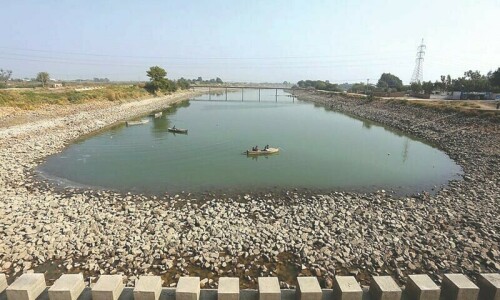
KARACHI: Two new species of cobia fish — the long, meaty variety often featured in Hollywood movies depicting fishing competitions — were discovered off the coast of Pakistan, according to a recently published study in peer-reviewed journal Zoologischer Anzeiger.
“At first glance, I thought it was another black king cobia but when I looked closer at the markings on its body, I knew it was different,” said Dr Sher Khan Panhwar, who along with his students was on a routine survey of the Gwadar fish harbour when he spotted the new species.
Dr Panhwar, a professor at Karachi University’s Center of Excellence in Marine Biology and co-author of the study, said he went to the coastal area of Balochistan along with his students last year to study black king cobia or Rachycentron canadum, a commercially popular large fish found across the world.
After the discovery, Dr Panhwar and his team offered the fishermen money in exchange for the fish. At first the fishermen refused, stating that the ‘Sangla’, a local name of the species before its discovery, had been booked by some buyers who enjoy its meat.
However, the team continued their efforts and finally with the help of some harbour officials managed to convince the fishermen and get their hands on specimens, weighing four and seven kilograms costing them about Rs16,000.
The specimens were then iced and sent to the laboratory which was 650km away from the Gwadar harbour, he said.
Back at the laboratory, Dr Panhwar and his colleague, Imtiaz Kashani, analysed the unusual cobias, examining their appearance, dissecting them, and comparing them with the typical species, they wrote in the study.
Soon clear patterns began to emerge.
The fish from Gwadar proved to be subtly yet consistently different, prompting the researchers to recognise that they had identified two new species.
One has been named the Blotchy Cobia, a nod to the large grey blotches marking found on its body and the Balochi language spoken in the region. The other is the Makran Cobia, named after the Makran coast where it was found.
“At this time, these species of cobia have only been spotted in Pakistan,” Dr Panhwar said.
According to the study, Blotchy Cobia (Rachycentron blochii), are “torpedo-shaped”, weighing around eight pounds and are three feet long. They have “small eyes” which are masked by a greyish shade, “pointed” snouts and teeth on their mouth, jaw and tongue.
The Makran Cobia (Rachycentron makranensis) are slightly smaller, weighing six pounds and are two and a half feet long. It features “short”, “pointed” eyes of “moderate size” and small teeth distributed across its jaws, tongue, and the roof of its mouth.
Published in Dawn, November 21st, 2024














































